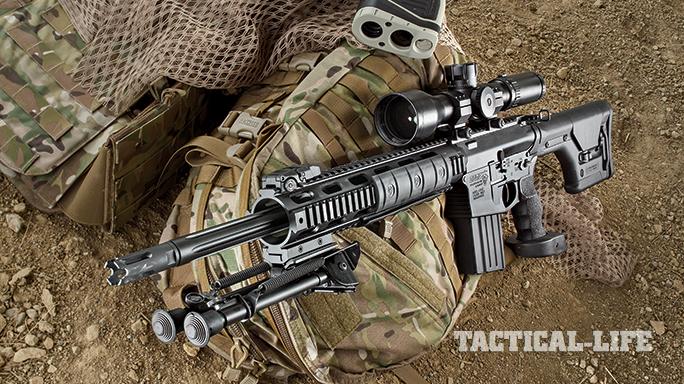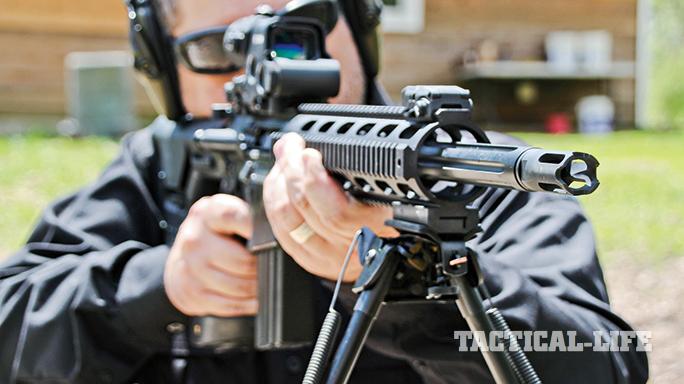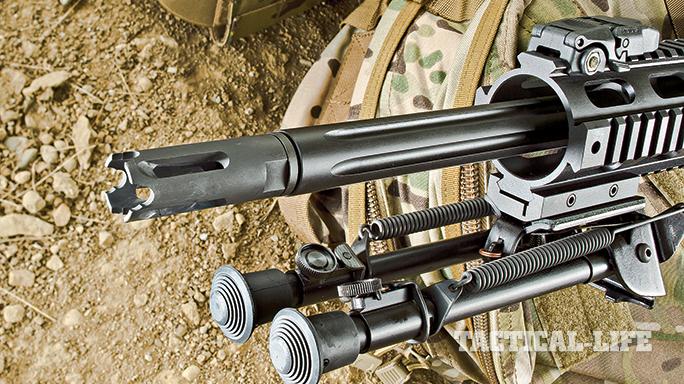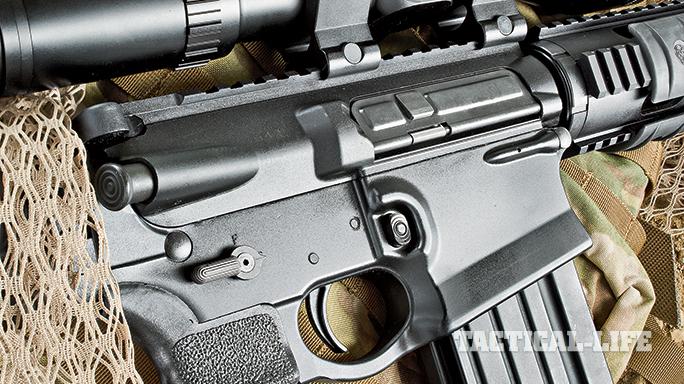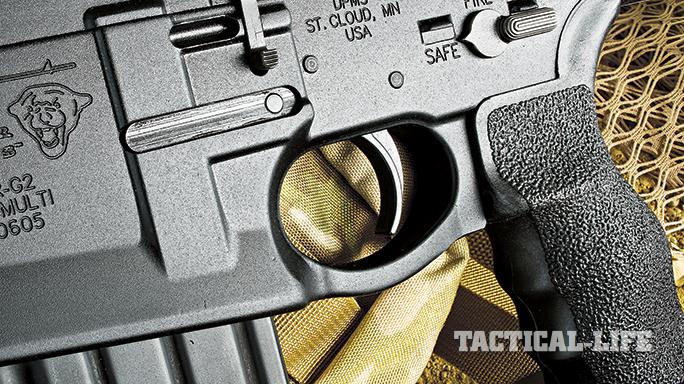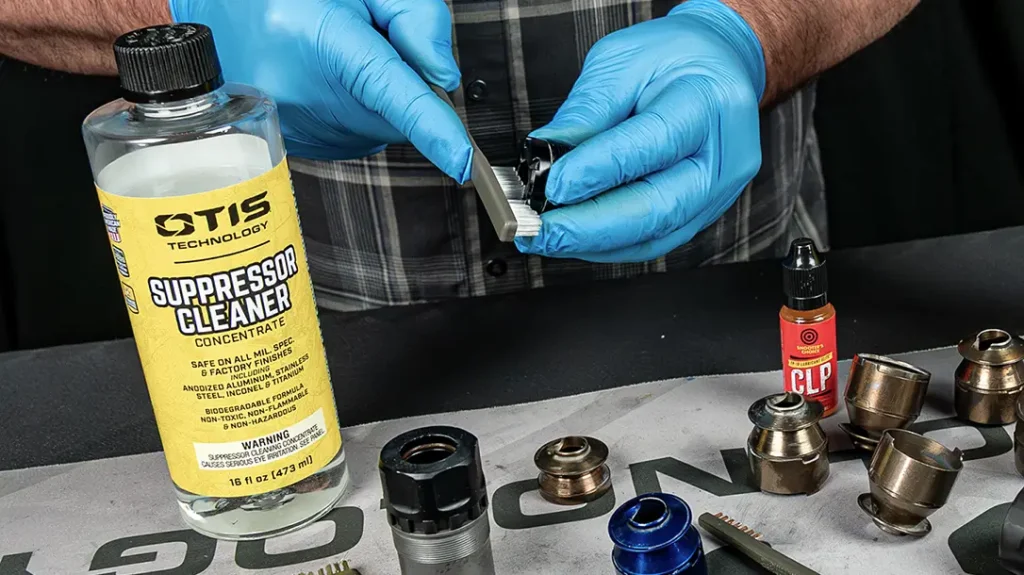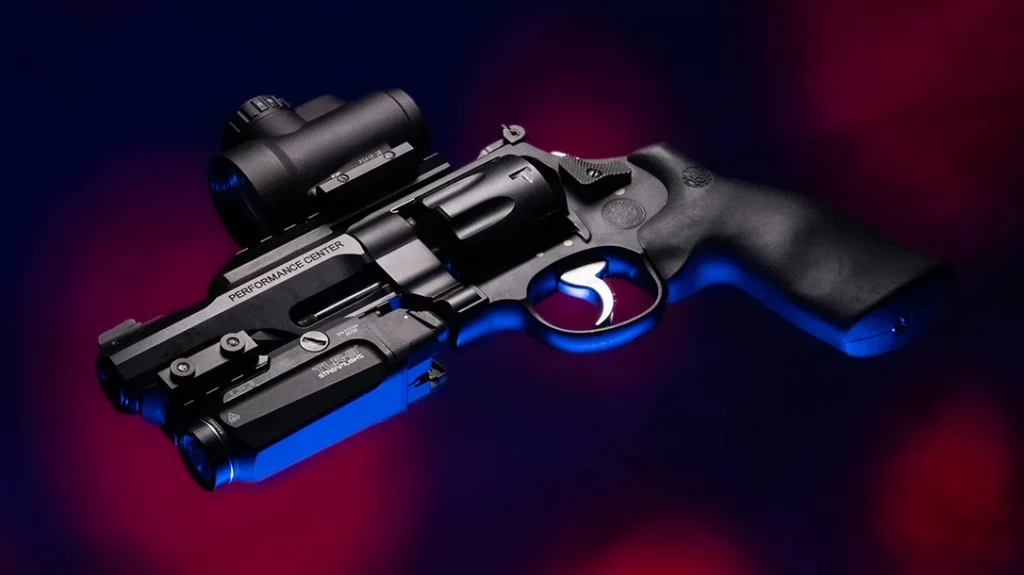DPMS, also known as Panther Arms, like many AR manufacturers has been producing and selling .308/7.62mm NATO-chambered ARs for many years now. These have proven to be very popular among sport shooters, hunters and law enforcement officers already familiar with the AR’s system of operation and desiring something with the increased punch and performance of the larger 7.62mm NATO round.
- RELATED: DPMS’ New GII Rifles in .308 Winchester/7.62mm NATO
- RELATED: Big Game AR Test: DPMS GII .308 Hunter
A tactical countersniper version of the DPMS 7.62mm AR called the SASS (which is an homage to the U.S. government’s “semi-automatic sniper system” program) has been available for many years and continues to be sold. According to the company, the winner of the sniper competition in the 2012 Can-Am Police-Fire Games used this rifle. However, now those interested in high performance and super-accurate semi-automatic firepower have a brand-new rifle to consider, the DPMS GII SASS.
GII Platform
Advertisement — Continue Reading Below
Most 7.62mm ARs are simply beefed-up versions of their 5.56mm cousins, but the GII is a very different animal. DPMS spent more than two years developing the GII, offering only fleeting glimpses of its work in progress to a few of us sworn to secrecy, and the end result was worth the wait. This rifle represents a game-changer in this market and features unique innovations and design differences that distinguish it from all other 7.62mm ARs. This rifle was designed to maximize parts compatibility between it and a standard 5.56mm AR so that the aftermarket accessories already available could be readily used on the new rifle.
“This is the first rifle I have tested that achieved sub-MOA results with every load I used.”
In the design process, the GII was made much lighter than other 7.62mm ARs and smaller while drastically improving its functioning and reliability. The new rifle will accept all standard AR pistol grips and fire control groups. It will accept most standard two-piece 5.56mm AR handguards and many free-floating 5.56mm handguards as well thanks to a new barrel nut system. Also, the buffer tube is standard for any AR and will accept any aftermarket stock.
Advertisement — Continue Reading Below
The upper and lower receivers are shorter and narrower than those for many other 7.62mm AR rifles. in fact, they are only half an inch longer than a 5.56mm AR and more than half an inch shorter than DPMS’ older LR-308 rifle. The height of the flattop upper receiver is identical to a 5.56mm AR so you can use standard AR backup sights without having to adjust them. The forged upper and lower receivers are made from 7075-T6 aluminum with a Type III hardcoat anodized and Teflon-coated finish that comes across as very smooth. All of the sharp edges on the receiver have also been smoothed for a comfortable feel.
The lower receiver also has an integral, enlarged triggerguard that makes it easier to use the rifle with gloved hands. The magazine well has been aggressively beveled to help speed up magazine changes, and the rifle will accept 7.62mm Magpul PMAGs. The front of the magazine well has horizontal serrations to provide a firm grip for those who use the magazine well as a forward grip.
The flattop upper receiver has a lengthened ejection port for more reliable ejection. This is combined with a longer dust cover to keep debris out of the action when not in use and a newly redesigned shell deflector with a concave face that catches spent brass and rotates it out of position for enhanced functioning. You also get a fully functional forward assist that helps greatly in chambering recalcitrant rounds. The charging handle was also redesigned and re-forged with a thicker section at the front, where breaks are most likely to occur. This provides a 45-percent increase in strength to prevent failures or malfunctions.
Advertisement — Continue Reading Below
While externally the DPMS GII is already impressive enough, the real engineering work and innovation can be found inside. The bolt carrier group is unlike any I have seen on other 7.62mm ARs. First, DPMS has reduced the overall mass of the bolt carrier group so that it has the same diameter as a standard 5.56mm bolt carrier group. The bolt carrier group has a monolithic gas key that, instead of being staked on, is forged as part of the bolt carrier group, making the part much stronger. The gas key has a removable extension for the gas tube as well, with an optimized gas ring to eliminate gas leakage during operation. A titanium firing pin is also included in the design.
The reduced-diameter bolt carrier group is made possible by a newly redesigned bolt. The bolt face has rounded locking lugs instead of the usual squared-off ones. This significantly increases the lockup strength, which allows for a lower-mass bolt carrier group. The internals of the bolt have also been radically improved with dual ejectors. These reduce spring fatigue and provide a redundant ejector system, increasing reliability and extending the lifetime of the parts.
DPMS has also created a more reliable and stronger extractor using an undisclosed proprietary material. This was paired off with a new elastomer extractor spring that improves the functioning of this part and extends its operational performance. DPMS tested this new system by firing thousands of rounds with no failures of any sort while subjecting the new materials to a wide variety of solvents and cleaners as well as temperature extremes from -60 to 650 degrees Fahrenheit.
Advertisement — Continue Reading Below
In order to improve functionality with all types of ammunition, DPMS installed a steel feed ramp in the GII. This allowed for changes in the barrel extension to make it and the receiver both lighter and smaller, which in turn is what allows the maximum compatibility with 5.56mm AR handguards and parts.
The rifle as a whole is indeed very lightweight for a 7.62mm AR, and when I first picked it up, it felt very similar in weight and dimensions to a 5.56mm AR. In fact, the standard DPMS GII weighs only 0.75 pounds more than a comparable 5.56mm AR, and yet, despite the reduced weight, DPMS claims it produces less recoil than other 7.62mm ARs.
GII SASS Details
Advertisement — Continue Reading Below
I had the chance to shoot the GII SASS before its formal introduction at various long ranges and found it extremely accurate and very soft shooting for a 7.62mm AR. This was especially impressive given that the new SASS weighs a few pounds less than the old one. Its accuracy is made possible thanks to an 18-inch, heavy-contour, fluted, 416 stainless steel, Teflon-coated, match-grade barrel with a 1-in-10-inch twist rate. It remains free-floating thanks to the quad-rail handguard. The barrel is topped off with a removable Panther flash suppressor that is extremely effective.
The Teflon coating provides superior corrosion resistance and a matte black finish while the fluting on the barrel reduces weight and adds structural rigidity, actually strengthening the barrel. Fluting also increases the surface area of the barrel, which means it will cool faster than a standard barrel. The rifle also features a mid-length gas system.
The quad-rail, free-floating handguard is made from one piece of 6000 series aluminum with a T6 heat treatment, and it features large cooling vents along its length. It will likely seem oversized to those accustomed to more svelte designs, but it is very sturdy and offers a significant amount of retail space along its 12-inch length for adding bipods, lasers, lights and optics, including night-vision devices mounted in front of standard optics. The SASS comes standard with rail covers for improved comfort and a pivoting and height-adjustable Harris bipod that neatly folds out of the way for transport.
Advertisement — Continue Reading Below
The rifle also features an ergonomic, black polymer Panther Tactical pistol grip with an ample palm swell and aggressive texturing. It also has a distinct palm shelf at the bottom that is height adjustable for a customized fit to align the hand and firing finger with the trigger and provide improved comfort during long-term use.
DPMS also added the Magpul PRS rifle stock. The user can adjust the comb height for perfect eye alignment with a given optic as well as the length of pull, which can be adjusted by 1 inch. Both function without tools using machined-aluminum rotating knobs that stay in place with positive locking click detents even under tough field conditions and repeated recoil. This polymer stock includes an aluminum buttplate with a rubber buttpad and reversible sling attachment points. At the toe of the stock there is also a removable cover that reveals a length of Picatinny rail for accepting a rear monopod.
As a designated precision rifle, the SASS is meant to be used with optics, but as a tactical rifle it is also equipped with Magpul folding front and rear backup sights. DPMS has also installed an extended tactical charging handle latch that helps with bolt manipulations when a larger scope is mounted.
Advertisement — Continue Reading Below
The trigger has also been significantly upgraded from a standard AR unit as befits a true precision rifle. Instead of the traditional military single-stage trigger, you get a custom two-stage match trigger. The first stage on my test rifle weighed 1.75 pounds and the second stage was 4.5 pounds. The trigger was extremely crisp with no creep or overtravel.
Range Time
On the range, the GII SASS performed flawlessly with zero malfunctions over two days of shooting with no maintenance performed in between. The recoil was very comfortable, and the accuracy was excellent. This is the first rifle I have tested that achieved sub-MOA results with every load I used. I shot the GII SASS for accuracy at 100 yards from a stable benchrest using the Trijicon TR20-2 AccuPoint 3-9x40mm scope with a mil-dot crosshair reticle.
Advertisement — Continue Reading Below
The new GII series of 7.62mm ARs from DPMS have been nothing but outstanding in every way during my testing, and the company truly invested the time and innovation to develop what I believe could be the standard for measuring all other ARs in this chambering.
For more information on the GII SASS, visit dpmsinc.com or call 800-578-3767.
